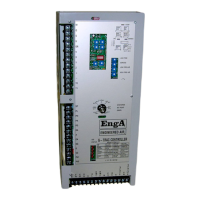

Do you have a question about the Engineered air EngA G-TRAC2 and is the answer not in the manual?
| Brand | Engineered air |
|---|---|
| Model | EngA G-TRAC2 |
| Category | Controller |
| Language | English |
Defines the unit's purpose in heating, vent, and MUA applications.
Guidance on technician familiarity with the manual before servicing equipment.
Overview of the G-TRAC2 as a programmed logic controller for heating.
Lists key operational and control capabilities of the G-TRAC2 unit.
Details operational time sequences for pre-purge, warm-up, and cool-down cycles.
Explains how the G-TRAC2 manages flow rates for combustion air and gas.
Covers configuration settings for A, B (Fuel/Air Curves), and C (Control Modes).
Lists and describes the 10 adjustable trim pots for various settings.
Explains LED indicators for operation modes and fault codes.
Manages low-limit conditions with bypass timers and lockout prevention.
Defines fan, damper, and heat control logic for day/night modes.
Outlines the sequence for burner start-up, ignition, and flame supervision.
Details using BMS signals for set point adjustment and calibration procedures.
Describes discharge air control with optional resets and night heat packages.
Details using the unit's face-mounted set point or a remote thermostat.
Explains how room temperature can adjust the discharge air set point.
Method for measuring discharge temperature via voltage readings.
Procedures for calibrating the discharge air temperature sensor.
Steps to calibrate the base discharge set point value.
Process for calibrating the room temperature sensor input.
Rules for operator movement and manual service mode for burner adjustment.
Step-by-step guide for setting gas and air operators for proper combustion.
Covers fuses, low limit lockouts, and solid-state contact issues.
Troubleshooting steps for issues with pilot ignition and flame sensing.
Addresses issues related to condensation within the unit.
Guidance on replacing the control unit and re-checking combustion.
Steps for replacing faulty gas or air operator motors.
Final notes on flame relay, flue gas, and O2 checks.